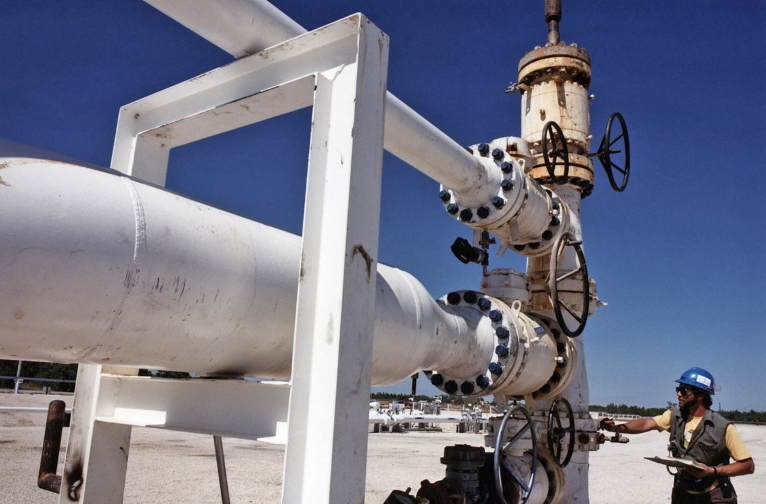“It’s all about the oil,” many commentators said about the US assault on Iraq in 2003.
Attributing a war to a single cause is almost always an oversimplification, but protecting access to the 20th century’s most important energy source has been a priority of US foreign policy since World War II.
In part one of this series we considered the effects of the US military complex which has ringed the world for the past 75 years. This complex has depended on vast amounts of fossil fuel energy to move troops and munitions, and the US became a world power in significant part because of its endowment of oil.
As Daniel Yergin recounts in The Prize: The Epic Quest for Oil, Money & Power
Petroleum was central to the course and outcome of World War II in both the Far East and Europe. The Japanese attacked Pearl Harbor to protect their flank as they grabbed for the petroleum resources of the East Indies. Among Hitler’s most important strategic objectives in the invasion of the Soviet Union was the capture of the oil fields in the Caucasus. But America’s predominance in oil proved decisive, and by the end of the war German and Japanese fuel tanks were empty.” (The Prize, Simon & Schuster, 1990, pg 13)
At the end of World War II the US was not only the world’s preeminent military force, but its industrial capacity was undamaged by war and it was running on seemingly abundant supplies of cheap domestic oil.
Spurred on by oil and car companies who had the most to gain from a high-energy way of life, the US embarked on a building spree of far-flung suburbs, interstate highways, and airports that allowed long-distance flight to become a routine activity.
This hyper-consumption was bolstered by a new economic orthodoxy which saw no need to factor in energy depletion when accounting for national wealth, and which portrayed exponential economic growth as a phenomenon that could and should continue decade after decade.
It took barely a generation, of course, for the US economy to suck up the bulk of its cheap domestic oil – conventional oil production peaked in the US in 1971. Did Americans then conclude they should change the basis of their economy, and make peace with reduced energy consumption? Far from it. Dependence on imported oil has now been a central feature of the US economy for fifty years.

Gap between US oil consumption and production. Chart by An Outside Chance for the post Alternative Geologies: Trump’s “America First Energy Plan”, from stats on ycharts.com
A world of vulnerability
The huge military complex which protects essential oil supply routes is sometimes seen as a sign of US strength, but it can just as accurately be seen as a sign of US weakness.
In a 2009 report entitled “Powering America’s Defense: Energy and the Risks to National Security”, a panel of twelve retired generals and admirals notes that “The U.S. consumes 25 percent of the world’s oil production, yet controls less than 3 percent of an increasingly tight supply.” This voracious appetite for oil, they say, is a dangerous vulnerability:
As we consider America’s current energy posture, we do so from a singular perspective: We gauge our energy choices solely by their impact on America’s national security. Our dependence on foreign oil reduces our international leverage, places our troops in dangerous global regions, funds nations and individuals who wish us harm, and weakens our economy; our dependency and inefficient use of oil also puts our troops at risk.” (Introduction to Powering America’s Defense)
One source of imported oil has outranked all others for the US and its western European allies. The US was already consolidating its “special relationship” with Saudi Arabia in the 1930s, in the first years of that country’s existence. As Timothy Mitchell describes this relationship,
Aramco [Arabian-American Oil Company] paid the oil royalty not to a national government but to a single household, that of Ibn Saud, who now called himself king and renamed the country … the ‘Kingdom of Saudi Arabia’. … This ‘privatisation’ of oil money was locally unpopular, and required outside help to keep it in place. In 1945 the US government established its military base at Dhahran, and later began to train and arm Ibn Saud’s security forces …. The religious establishment, on the other hand, created the moral and legal order of the new state, imposing the strict social regime that maintained discipline in the subject population and suppressed political dissent.” (Timothy Mitchell, Carbon Democracy, Verso, 2013, pg 210-211)
The alliance between a self-styled liberal democracy and an theocratic autocracy has not been a marriage made in heaven. But in spite of many points of tension the relationship has benefited powerful forces in both countries and has endured for most of the age of oil.
The need to protect US access to the world’s largest sources of conventional oil was formally recognized in the Carter Doctrine:
An attempt by any outside force to gain control of the Persian Gulf region will be regarded as an assault on the vital interests of the United States of America, and such an assault will be repelled by any means necessary, including military force.” (US President Jimmy Carter in his State of the Union Address, January 1980)
Ironically, this doctrine led the US to begin supporting the mujahideen, Islamic fundamentalists who were fighting the Soviet Union in Afghanistan. And ironically, after the Soviet-Afghan war ended one of the major irritants for the formerly lauded “freedom fighters” was the heavy military presence of the infidel United States in Saudi Arabia. The result has been almost 20 years of continuous warfare between the US and various offshoots of the mujahideen, with no prospect of victory for the US.
The costs of these wars, merely in dollar terms, have been staggering. While US military expenditures have remained high ever since World War II, these costs have recently gone through the roof. An analysis of military spending by Time in 2013 found that inflation-adjusted military spending in the 2000s was approximately twice as high as military spending in the 1960s, during the nuclear face-off with Russia and the massive deployment in Indochina.
In sum, the US has been importing increasing quantities of increasingly expensive oil for decades. During the same years US military spending has soared. Does this sound like a recipe for solvency? You might well wonder if it’s just coincidence that US national debt has soared during these years.

US national debt converted to 1983 dollars and plotted on logarithmic scale – each step up the ladder is 10 times as high as the previous step – by Stephen Bloch of Adelphi University.
Recall the curious formulation by John Dower cited in the first installment of this series:
Creating a capacity for violence greater than the world has ever seen is costly – and remunerative.” (The Violent American Century, pg 12, emphasis mine)
How is this world-wide military occupation remunerative? In our next installment we’ll look at the tie-in between the power that grows out of the barrel of a gun, and the power that comes with control of currency.
Teaser photo credit: well head at the Big Hill, Texas site of the US Strategic Petroleum Reserve. The Big Hill facility stores up to 160 million barrels of oil. The four sites of the Strategic Petroleum Reserve were developed in the 1970s, amid fears that a disruption in global supply lines could leave the US dangerously vulnerable. Photo from US Office of Fossil Energy.






